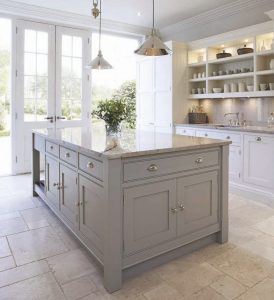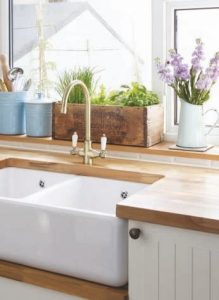Stylish Surfaces
The workhorses of any kitchen, worktops need to be tough and practical to use, as well as stylish.
While cabinetry may be the main style decision you make for your kitchen, never underestimate the impact your worktop choice will have on the overall scheme. It’s important to give it due consideration and not to view it as an afterthought.
Here’s what you should consider before you invest in a countertop.
Your budget
Worktops are available at a variety of price points – from cheaper laminates to expensive granites. Cheaper options can be a good idea but may not last as long as more durable stones or composites.
Your kitchen layout
If this has already been decided, it can give you a good steer towards what worktop might be best. Straight runs are cheaper and easier to fit, while seamless materials such as composites make sense if you have lots of corners.
Added costs
Choose your profile
The depth of worktop you choose can also alter the look of a kitchen. Thinner profiles of 10 or 20mm are still popular but thicker edges are also having a resurgence. The standard thickness is 30mm.
Mix it up
Don’t rule out mixing two materials – a marble slab with wooden worktops, say, or a stainless steel island with a wooden breakfast bar attached. Different materials can serve different culinary purposes, and can also be used to visually order your kitchen.
Choose the best kitchen worktop material for you. The most popular materials for kitchen materials – laminate, granite, wood, glass, composite stone, stainless steel – have different advantages, so it’s important to look at all the factors involved.
Hardwood worktops
A traditional favourite for its natural warmth and the character that comes as it ages, hardwood is preferred over ‘soft’ woods like pine for its strength. Popular choices of hardwood include oak and walnut. Always choose a sustainable hardwood, preferably from an FSC (Forest Stewardship Council) accredited source.
If hardwoods are properly sealed and maintained they will last for a long time, but don’t use the worktop as a chopping board, or place hot pans directly onto the wood as it can scorch
Hardwoods require an initial programme of sealing using oil. Apply a coat once a day for the first week, then once a week for the next month, then once a month for a year.
Avoid direct exposure to heat and prolonged soaking, especially by the sink and tap area. Wipe up spills instantly to prevent staining
Once established, seal with Danish or linseed oil quarterly to stop drying out. Avoid using any abrasive and chemical-filled cleaning products or wire scouring pads.
Composite worktops
Made from about 90% natural quartz crystals mixed with a small percentage of binders, and referred to as both ‘quartz composite’ and ‘engineered stone’, this material is very tough, virtually non-porous and resistant to scratches, stains, heat damage and impact, and often comes with a long warranty.
It also offers consistent composition so, unlike natural stone, there won’t be variation in veining and colour shading.
This is a very practical and beautiful choice that can be used anywhere, including next to the hob and around the sink.
Composite is very tough and more durable than many natural stones. As the colour runs right the way through the material, any scratches can be sanded out. In the very unlikely
Granite worktops
For some, nothing beats the beauty of natural stone,
Granite is hard and resistant to heat and scratches, but it must be treated with respect to
One great thing about granite is that it’s very low maintenance. You can clean it using a damp cloth and a mild detergent.
Laminate worktops
Long considered the best budget option, laminates are non-porous, offer easy maintenance and come in lots of design and colour choices. Made by fusing multiple layers of impregnated paper under
They resist most stains and chemicals, but not heat or steam and are not suitable as a cutting surface. Choose a thicker, high-pressure worktop for greater durability.
Laminate is one of the few materials that can be cut and fitted by a DIY enthusiast rather than a kitchen professional. It is very low maintenance: clean with a cloth and mild detergent.
Granite overlays
What distinguishes a granite overlay worktop from all others is the remarkable ‘top that fits on top’.
Unlike regular work surfaces, the material is made only a quarter of an inch (6.7mm) thick and is especially lightweight, so that it can be installed over existing worktops without removing the original or needing extra underpinning.
For traditional kitchens, go for the look and feel of natural stone worktops, choosing either Italian granite or ultra-contemporary recycled glass. Black or white surfaces, some with mirror fleck, give an upscale look and check out the latest porcelain worktops too. Waterfall ends, right down to floor level, look elegant and stylish.
Posted in: Interiors







